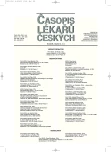Endocannabinoid system II – the role in addictive behaviour, depression and in pathology of eating behaviour
Authors:
Martykánová L.
Authors place of work:
Ústav preventivního lékařství LF MU, Brno
Published in the journal:
Čas. Lék. čes. 2010; 149: 368-371
Category:
Přehledový článek
Endokanabinoidní systém je součástí neurobiologického mechaniSmu, který je podstatou drogové závislosti u všech známých typů drog včetně nikotinu a alkoholu. Nedávno byla objevena i spojitost endokanabinoidů s biologickou podstatou deprese a poruchami příjmu potravy. Byly objeveny polymorfismy genů kódujících kanabinoidní CB1 receptory a genů kódujících hlavní degradační enzym FAAH, které jsou zodpovědné za vznik patologií v oblasti motivace a nálady.
Summary
Endocannabinoid system is involved in the neurobiological mechanism underlying drug addiction in all known kinds of drugs including nicotine and alcohol. Recently, relationships between endocannabinoids and biological nature of depression and eating disorders were recognised. Polymorphisms of genes encoding CB1 receptors and genes encoding main degrading enzyme FAAH responsible for pathology in motivation and cognition were identified.
Key words:
endocannabinoids, endocannabinoid system, reward system, addiction, eating disorders.
Zdroje
1. Maldonado R, Valverde O, Berrendero F. Involvement of the endocannabinoid system in drug addiction. Trends in neuroscience 2006; 29(4): 225–233.
2. Gardner EL. Endocannabinoid signaling system and brain reward: Emphasis on dopamine. Pharmacology, Biochemistry and Behavior , 2005; 81(2): 263–284.
3. De Vries TJ, Schoffelmeer AN. Cannabinoid CB1 receptors control conditioned drug seeking. Trends in Pharmacological Science 2005; 26(8): 420–426.
4. Drago F. Endocannabinoids and psychopathology: The therapy inside. Pharmacological Research 2007; 56(5): 357–359.
5. Hanuš LO, Šulcová A, Miovský M. Editorial. Adiktologie 2004; 4(4), 457–461.
6. Šulcová A. Endokanabinoidní systém mozku a psychózy. Psychiatrie 2005; 9(3): 307–316.
7. Mäki P. Predictors of schizophrenia – a review. British Medical Bulleti, 2005; 73–74(1): 1–15.
8. Cohen C, Kodas E, Griebel G. CB1 receptor antagonists for the treatment of nicotine addiction. Pharmacology, Biochemistry and Behavior 2005; 81(2): 387–395.
9. González S, et al. Changes in cannabinoid contents in brain of rats chronically exposred to nicotine, ethanol or cocaine. Brain Research 2002; 954(1): 73–81.
10. Racz I, et al. A critical role for the cannabinoid CB1 receptors in alcohol dependence and stress-stimulated ethanol drinking. Journal of Neuroscience 2003; 23(6): 2453–2458.
11. Hungund BL, et al. Cannabinoid CB1 receptor knockout mice exhibit markedly reduced voluntarey alcohol consumption and lack alcohol-induced dopamine release in the nucleus accumbens. Journal of Neurochemistry 2003; 84(4): 698–704.
12. Basavarajappa BS, et al. Increased ethanol consumption and preference and decreased ethanol sensitivity in female FAAH knockout mice. Neuropharmacology 2006; 50(7): 834–844.
13. Rubio M, et al. Short-term exposure to alcohol in rats affects brain levels of anandamide, other N-acylethanolamines and 2-arachidonoyl-glycerol. Neuroscience Letters 2007; 421(3): 270–274.
14. Rossi S, et al. Caffeine drinking potentiates cannabinoid transmission in the striatum: interaction with stress effects. Neuropharmacology 2009; 56(3): 590–597.
15. Haller J, et al. The effects of genetic and pharmacological blockade of the CB1 cannabinoid receptor on anxiety. European Journal of Neuroscience 2002; 16(7): 1395–1398.
16. Vinod KY, Hugund BL. Role of the endocannabinoid system in depression and suicide. Trends in Pharmacological Sciences 2006; 27(10): 539–545.
17. Gobbi G, et al. Antidepressant-like activity and modulation of brain monoaminergic transmisssion by blockade of anandamide hydrolysis. Proceedings of the National Academy of sciences 2005; 102(51): 18620–18625.
18. Mennella JA, et al. Sweet preferences and analgesia during childhood: effects of family history of alcoholism and depression. Addiction 2010; 105(4): 666–675.
19. Volkow ND, Wise RA. How can drug addiction help us understand obesity? Nature Neuroscience 2005; 8(5): 555–560.
20. Wang GJ, et al. Brain dopamine and obesity. Lancet 2001; 357(9253): 354–357.
21. Frieling H, et al. Elevated cannabinoid 1 receptor mRNA is linked to eating disorder related behavior and attitudes in females with eating diorders. Psychoneuroendocrinology 2009; 34(4): 620–624.
22. Guanini F. Neural contractions in colonic strips from patients with diverticular disease: role of endocannabinoids and substance P. Gut 2006; 55(7): 946–953.
23. StŅving RK, et al. Leptin, ghrelin, and endocannabinoids: Potential therapeutic targets in anorexia nervosa. Journal of Psychiatric Research, 2009; 43(7): 671–679.
24. Monteleone P, et al. Blood levels of the endocannabinoid anandamide are increased in anorexia nervosa and in binge.eating disorder, but not in bulimia nervosa. Neuropsychopharmacology 2005; 30(6): 1216–1221.
25. Monteleone P, et al. The cDNA 385C to A missense polymorphism of the endocannabinoid degrading enzyme fatty acid amide hydrolase (FAAH): is associated with overweight/obesity but not with binge eating disorder in overweight/obese women. Psychoneuroendocrinology 2008; 33(4): 546–550.
26. Monteleone P, et al. Association of CNR1 and FAAH endocannabinoid gene polymorphisms with anorexia nervosa and bulimia nervosa: evidence for synergistic effects. Genes, Brain and Behavior 2009; 8(7): 728–732.
27. Berry EM. Pilot study of THC (2,5 mg × 2) in 9 ambulatory AN patients (abstract). In: The sixth nordic congress on eating disorders. Denmark: Aarhus 2006.
28. Gross H, et al. Double-blind trial of DELTA 9‑tetrahydrocannabinol in primary anorexia nervosa. Journal of Clinical Psychopharmacology 1983; 3(3): 165–171.
Štítky
Adiktologie Alergologie a imunologie Angiologie Audiologie a foniatrie Biochemie Dermatologie Dětská gastroenterologie Dětská chirurgie Dětská kardiologie Dětská neurologie Dětská otorinolaryngologie Dětská psychiatrie Dětská revmatologie Diabetologie Farmacie Chirurgie cévní Neurologie Praktické lékařství pro dospělé Revmatologie Algeziologie Dentální hygienistkaČlánek vyšel v časopise
Časopis lékařů českých

- Přerušovaný půst může mít významná zdravotní rizika
- MINISERIÁL: Když ženám stoupá tlak...
- Tirzepatid – nová éra v léčbě nadváhy a obezity
- Ukažte mi, jak kašlete, a já vám řeknu, co vám je
Nejčtenější v tomto čísle
- Výskyt mikrokarcinomů štítné žlázy u operovaných pacientů – retrospektivní analýza
- Endokanabinoidní systém II – úloha v adiktivním chování, depresi a při vzniku patologií potravního chování
- Endokanabinoidní systém I – úloha v regulaci fyziologických funkcí organismu
- Priniesla zmena manažmentu u chorých s ťažkou akútnou pankreatitídou očakávaný výsledok?
